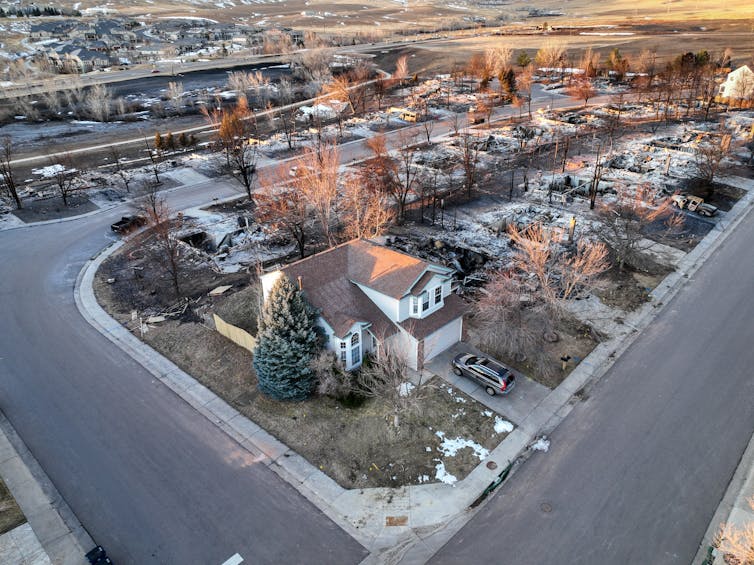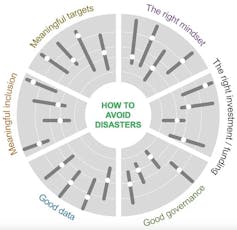When a huge cyclone slammed into East Pakistan (present day Bangladesh) in November 1970 it caused water in the Ganges Delta to rise by 10 metres. Entire towns were submerged. At least 300,000 people died – it remains atop lists of the deadliest known tropical cyclones.
Something similar happened in 1991 – another 139,000 deaths. Bangladesh has a long list of cyclones with five or six figure death tolls.
These days, Bangladesh has a much larger population and is still getting hit by huge cyclones and widespread flooding. These storms are getting stronger. But these more recent cyclones have each led to only dozens of deaths.
This is what prompted our research project on “Disasters Avoided”. We frequently see headlines about disasters. But where are the headlines covering the good news of lives saved and damage averted when disasters do not happen? Our work, now published, offers examples we can learn from.
We started by seeking examples of disasters that had been avoided. There had to be a major environmental hazard – such as a tornado, earthquake, drought, wildfire, pathogen, landslide, volcanic eruption or heatwave – that didn’t lead to major casualties or disruption. And that had to be because disaster prevention actions were completed before the hazard struck.
In total, we looked in-depth at a dozen examples covering every inhabited continent. Some of the examples we found were very local. For instance a poorly extinguished campfire ignited a wildfire in the mountains of Colorado in July 2016. No one died, but 2,000 people were evacuated and eight houses completely burned.
Eight other houses in the torched forest survived. They were all certified by an NGO called Wildfire Partners as having taken its advice on using fire-resistant materials, removing fire-prone vegetation and storing woodpiles away from the house. While one homeowner was able to reoccupy their house immediately, their neighbour had to start rebuilding from scratch.

Other examples are wider-scale. The reduction in cyclone deaths in Bangladesh was thanks to a long-term education, preparedness, warning, evacuation and sheltering programme. Actions included making schools a relatively safe place for people to shelter in, and giving volunteers megaphones to cycle around villages warning people. The death count should still be reduced much more, but the improvement over time is clear.
Vietnam also experiences major floods every year, with almost 12 million coastal people exposed. One five-year project is providing 4,000 flood-resilient houses, while planting coastal mangroves to deal with storm surges. In late 2019, storm Matmo struck Quang Ngai, destroying many houses. Many new flood-resilient houses survived, keeping people safe and supporting agriculture-based livelihoods.
Scaling up
Individual case studies are important. But if they are to be useful we need to identify what they can teach us, so we can scale up the local and national successes and transfer lessons to other places. We found six overall patterns:

The right mindset to tackle the root causes of disasters and to focus on avoiding them. The right mindset includes understanding that disasters do not come from nature, so we do not use the phrase “natural disaster”. They are just disasters. They come from the choices we make to live and build in harm’s way, or more frequently to force people to live and work in harm’s way, without having the political power, resources, or opportunities to help themselves deal with hazards.
The right investment at the right time, including showing the evidence that it’s money well spent.
Good governance means well-managed investments and funds that deliver meaningful social, environmental, and livelihood benefits. It promotes actions that must be informed, accountable, and enforced.
Good data directs good decision-making. We should collect, analyse and act on good data. This data can take many forms and includes the obvious demographic and economic stats, but also observations from satellites, drones, or on-the-ground instruments, or people’s perceptions and experiences.
Meaningful inclusion of everyone, to agree on how we create a society that can withstand and live with nature’s energies and forces.
Targets that are realistic and achievable with the available resources. When appropriate, targets can be set, managed and linked to global efforts including the Sendai Framework for Disaster Risk Reduction, the UN’s Sustainable Development Goals, climate change agreements, and those on urban, and humanitarian agendas.
These principles also reveal that not all disasters avoided are due to forethinking. Luck can play a role – in some cases, a disaster was avoided simply because there weren’t many humans living in the hazard-affected area. In other cases a disaster was avoided because short-term actions were taken (safe evacuation and sheltering, for instance), and other times because longer-term actions were taken (such as supporting flexible livelihoods that could be restarted immediately after a major hazard).
These categories indicate how we could and should do better, especially by trying to encourage active work towards longer-term planning and preparedness.
Our work on disasters avoided continues, highlighting that everyone needs to be involved. We are documenting private sector examples of successes while describing the importance of innovation.
Overall, the baseline that we see time and again in avoiding a disaster is that success comes when a wide variety of people and groups come together in a symphony of action. Disasters are avoided when everyone cares for everyone.
Ilan Kelman receives research funding from UK research councils, the Wellcome Trust, and NASA who partly supported the research reported here, as well as internal UCL funding. He is Professor II at the University of Agder in Norway, Visiting Researcher at Heidelberg Institute of Global Health in Germany, and co-directs the non-profit organisation Risk RED (Risk Reduction Education for Disasters).
Ana Prados receives funding from NASA, who funded part of the research conducted for this article. She is a Senior Research Scientist at the University of Maryland, Baltimore County
Gareth Byatt receives research funding from NASA who partly supported the research reported here. He is an independent consultant and a member of the Institute for Risk Management (the IRM).
Brady Podloski does not work for, consult, own shares in or receive funding from any company or organisation that would benefit from this article, and has disclosed no relevant affiliations beyond their academic appointment.
This article was originally published on The Conversation. Read the original article.







